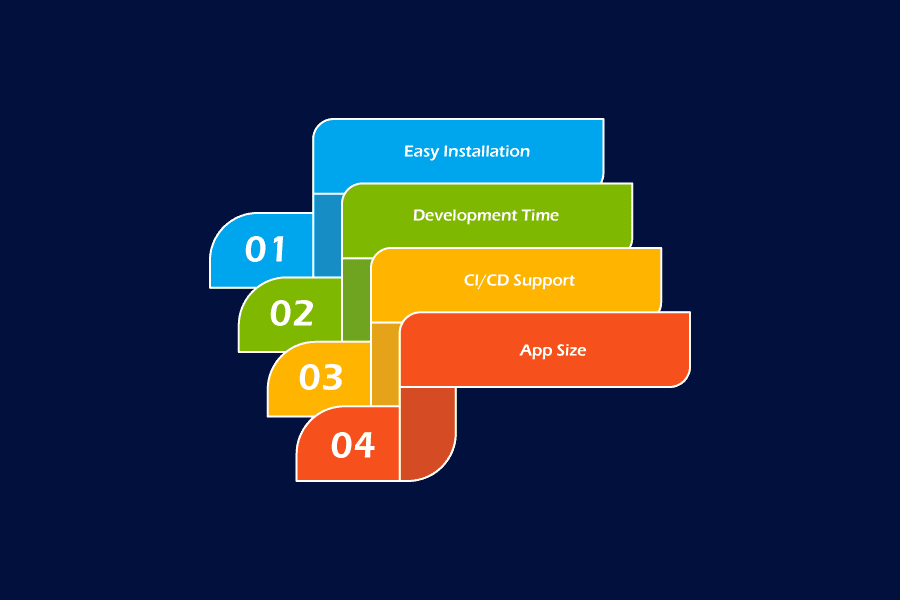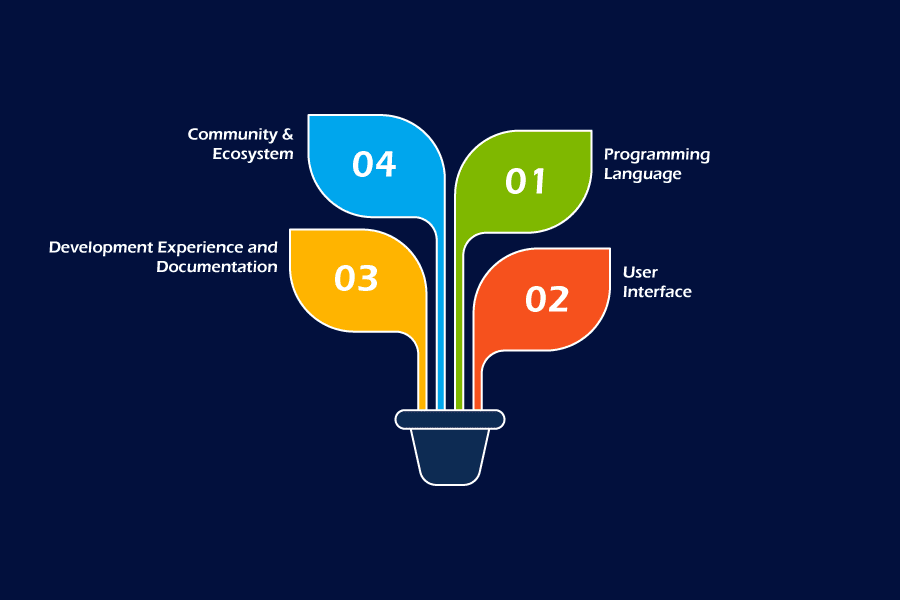
To build a mobile app for both iOS and Android, cross-platform frameworks such as Ionic, React Native, Flutter, Xamarin, and Node are often considered to determine which one to use for the purpose. Flutter and React Native usually top this list. With their individuality, they fiercely compete with one another. Both technologies promise faster development, a single codebase, and reduced time-to-market — but choosing between them is not as simple as picking the newer or more popular option.
Flutter, backed by Google, is highly acclaimed for its robust UI capabilities and user-centric design. React Native, maintained by Meta (formerly Facebook), occupies a significant niche due to its JavaScript-based approach, large community, and easier integration with native modules.
In this blog, we briefly discuss which one is better for cross-platform app development – Flutter vs. React Native.
- Decoding the Concepts: The Development Structures of Flutter and React Native Programming
- Key Aspects of Flutter App Development & React Native App Development
- Pros and Cons of Flutter and React Native App Development
- Here is Something About Flutter and React Native That We Haven’t Talked About Before
- Final Words
- Frequently Asked Questions
Decoding the Concepts: The Development Structures of Flutter and React Native Programming
Multiple setups and coding languages foster potential custom mobile app development; however, Flutter and React Native are the most popular amongst them.
Flutter App Development
Flutter, powered by Google, is a cross-platform framework that gives exceptional performance on both iOS and Android. It relies on the programming language called Dart and can utilize a single codebase for multiple platforms. With a self-controlled architecture, Flutter app setup has its own design components, complete creative controls, and creates everything from scratch.
React Native App Development
React Native is a Framework by Facebook/Meta, and is also a cross-platform setup that works as smoothly on iOS as it does on Android. Unlike Flutter, React Native utilizes native building blocks and works with a language called JavaScript, along with its extension JSX (which most developers are already familiar with).
Key Aspects of Flutter App Development & React Native App Development
Both frameworks facilitate custom mobile app development, catering to users in their unique way. Ultimately, in both programming formats, a single code enables you to establish your digital presence. However, certain key aspects would allow users to choose their priority between the two. What are those aspects? Let‘s explore:
Flutter App Development

- Programming Language:
Google introduced a programming language for Flutter called Dart in 2011.
- User Interface:
Having exceptional UI components, they have in-built widgets and do not rely on native platform components. Moreover, it also leverages a personal visual structural platform, which ensures consistency across different platforms and is ideal for apps with complex UI elements.
- Development Experience and Documentation:
Dart is quite unfamiliar to many developers; however, it is easy to work with, primarily for those who have already worked using object-oriented languages. Also, Flutter’s format and detailed content provide streamlined and easy-to-read documentation.
- Community & Ecosystem:
Being backed by Google, Flutter has witnessed immense community growth over time. With a dynamic ecosystem, a range of plugins and packages. However, Flutter is still working on maturing its architecture.
React Native Development
- Programming Language:
Facebook developed JavaScript and backed the React Native framework that enabled developers to build native-like custom mobile apps. It is compatible with iOS and Android, which React Native a potential resource for cross-platform app development services.
- User Interface:
React Native relies on native components for both iOS and Android. It has a substantial collection of external UI toolkits that allow developers to create an exquisite user interface.
- Development Experience & Documentation:
React Native Development utilizes JavaScript, a single codebase language that is widely used by developers and facilitates cross-platform app development projects with ease. Moreover, its hot reload feature enables developers to perform programming tasks with enhanced productivity. Nevertheless, it’s the general documentation process is a little vague and depends on an external development kit.
- Community & Ecosystem:
Being in the market, React Native is popular for its massive and mature ecosystem. Due to the vast community support, it offers an array of libraries and tools, making it another potential resource for custom app development services.
Pros and Cons of Flutter and React Native App Development
With an inquisitive efficiency, the two most promising cross-platform mobile app development frameworks are often compared on diverse parameters. However, most users find both sufficiently competent, which usually leads to confusion between the two. Let’s have a fair comparison between the pros and cons of both to determine what’s best for your cross-platform mobile app development requirements.
Pros of Flutter and React Native Development
| Flutter | React Native |
|---|---|
| Highly consistent UI across iOS & Android | Feels more “native” due to platform-specific components |
| Excellent performance, close to native | Good performance, especially for simpler apps |
| Rich set of pre-built widgets for fast UI building | Easier to find developers due to JavaScript’s popularity |
| Strong community support and backed by Google | Huge plugin ecosystem and mature community |
| Hot reload for quick testing and changes | Hot reload is also available for efficient development |
Cons of Flutter and React Native Development
| Flutter | React Native |
|---|---|
| Larger app sizes | May have performance issues with complex UI animations |
| Dart is less commonly used – smaller talent pool | Plugins can be inconsistent or poorly maintained |
| Slightly steeper learning curve for beginners | JavaScript bridge can cause lag in some scenarios |
| Fewer third-party libraries compared to RN | UI might vary slightly across platforms |
| Integrating advanced native features requires effort | Debugging can get tricky with multiple layers |
With an ideal image of both frameworks, one is known for its immaculate app design and development interpretation, whereas another is popular for its robust native-like components and programming ecosystem. However, the significance of their other crucial factors is contingent on the user’s requirements and may vary from project to project.
Here is Something About Flutter and React Native That We Haven’t Talked About Before

Here are some other vital elements that not everyone generally shares about Flutter and React Native frameworks. However, with this information, we aim to provide you with a clearer picture of both efficient custom app development structures.
- Easy Installation
You can easily install React Native using the Node Package Manager, whereas installing the Flutter development kit requires additional steps.
- Development Time
With JavaScript as the programming language and built-in capabilities to quickly juggle between the different iOS and Android designs, React Native development has an advantage over Flutter.
- CI/CD Support
Having a command-line interface, Flutter can set up continuous integration (CI) and continuous delivery (CD) with less effort and time. In contrast, React Native falls behind in offering a setup of CI and CD services. To be specific, in the case of cross-platform app development, CI/CD support is an important requirement, which Flutter meets successfully.
- App Size
Flutter uses its own engine and rendering setup, which makes React Native applications comparatively smaller than the size of Flutter’s apps.
Final Words
Choosing the proper framework for your cross-platform app is an essential yet daunting task, especially when you are unsure of the framework that best complements your needs. While both are competitive, but its more about what aligns with your team goals and timeline. For instance –
- If speed to market and web integration are priorities, React Native might be a better fit.
- If design flexibility and long-term performance are your top priorities, Flutter could give you the edge.
If you still need assistance with this, the best approach is to work with professional mobile app developers like Soluzione, who can not only provide clarity but also help you build scalable, intuitive, and cost-effective mobile apps.
Read More: https://www.solzit.com/blog/
Frequently Asked Questions
Which is more suitable for faster app development: Flutter or React Native?
React Native is more suitable for faster app development. It is already familiar to most developers, has a massive tool and widgets package, a wider community, and a larger ecosystem. However, Flutter is more compatible for applications with a little complicated UI.
Is Flutter or React Native more popular among developers in 2025?
Yes, both Flutter and React Native are popular among developers in 2025 for cross-platform app development services.
What programming languages are used in Flutter and React Native?
Flutter uses a programming language called Dart, whereas React Native uses a programming language called JavaScript.
Can I switch from React Native to Flutter easily?
Yes, you can switch from React Native to Flutter. However, it is not an easy task. Both frameworks have their own uniqueness in terms of language, interface, libraries, and more. Hence, switching between the two depends on your team’s skill set, experience, and project requirements. However, our proficient cross-platform app development experts can assist you with this and ensure a hassle-free transition from React Native to Flutter.










